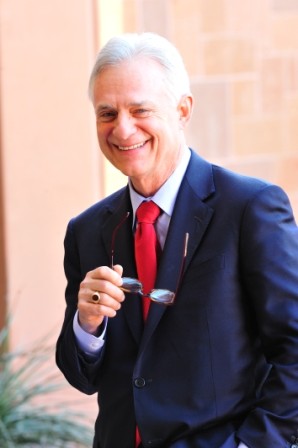What Lies Beneath the Surface?
By Karyn M. Halpern DMD, MS
Sponsored by Ivoclar
A 40-year-old otherwise healthy female presented for an initial exam with a chief complaint of, “I hate the color of my front tooth and would like it fixed”. She reported her tooth had fractured after a fall when she was just thirteen years old. She stated her previous dentist “bonded” it and she has not had it replaced since. She denied any discomfort or sensitivity. Her motivation for treatment was cosmetic as she was self- conscious on how it appeared.
Initial examination and x-ray findings revealed the maxillary left central incisor, tooth #9, had a history of a Class III (MFL) composite restoration as well as a facial composite veneer. The appearance of tooth #9 was very dark in shade and stood out like a sore thumb amongst what would otherwise be a very esthetic smile (Figure 1). A series of both extraoral and intraoral diagnostics photos were taken. The discolored and darker value of #9 appeared to be visible from both the facial and palatal aspects (Figure 2). The value and chroma appeared closest to shade A4 on the Vita shade guide, where the remaining dentition was significantly brighter, A1 (Figure 3).

Figure 1: Initial presentation with chief complaint of discolored unesthetic previously bonded tooth #9

Figure 2: Extraoral and intraoral facial and palatal views of initial presentation with very dark tooth #9

Figure 3: Initial shade and chroma of tooth #9 closest to shade A4
It was noted that there was also some minor incisal chipping present on #8 as well. Patient declined any restorative treatment to #8 and wanted to focus on treating #9 as a single unit.
Treating a single central incisor alone maybe one of the most challenging esthetic treatments a dentist performs.
In this case, the challenges, and potential limitations of what may be able to be accomplished with retreating #9 alone were even more concerning since it appeared so very dark. The questions and concerns were many. Is the tooth nonvital? How dark is the prep going to be? What materials will work best to block it out if necessary? How will I best block out a very dark prep and still mimic the high translucency present in her adjacent teeth? Maybe endo and pre-prosthetic internal bleaching, composite opaquers, or an MO coping?
Although often the most challenging, these cases can also be the most rewarding for both doctor and patient alike. I was up for the challenge and after interviewing the patient at length, I was confident I could manage and meet her expectations.
Since the tooth appeared very dark and had a history of trauma, the patient was referred for an endodontic evaluation prior to proceeding. The endodontist reported that #9 tested vital within normal limits. However, he advised in the event the prep was very dark, he could perform a pre-prosthetic root canal therapy to facilitate internal bleaching.
The patient returned for digital impressions with the Primescan, and the case was sent to the lab technician for a digital diagnostic wax up of tooth #9. A printed model and putty index of the digital wax up were fabricated.
Next, the patient presented for a pre-scheduled “prep and temp” visit. The plan was to remove the previous discolored resin restorations and clinically evaluate what lied beneath it all. Depending on how dark the prep, it would be determined which treatments would be best indicated to lighten as needed. A provisional was planned to allow for any additional treatments to be rendered.
I began to strip the bonding and prep the tooth for a conservative cingulum sparing ¾ crown. Once I removed the bonding, I began to smile to myself underneath my mask. The prep was not dark after all! I was pleasantly surprised. It was actually A1 (Figure 4). The patient was advised, good news, I am not going to need to place a temporary crown after all. No need for pre-prosthetic root canal therapy or internal bleaching. I can make your permanent crown today.

Figure 4: Prep shade light in value closest to A1 shade
The preparation was completed and scanned with the CEREC Primescan in the usual fashion. The digital diagnostic model was scanned, and the final restoration designed using Biocopy (Figure 5). The final restoration was fabricated with IPS e.max CAD MT A1 for the perfect balance of strength and translucency. Since the prep shade was ideal in value, the MT block (medium transclucency) was selected because it provides a very naturally translucent enamel replacement. Clinical experience has also demonstrated IPS e.max CAD certainly stands the test of time.

Figure 5: CEREC Primescan digital impressions of printed digital diagnostic of wax up stitched to marginated preparation
Once milled, the line angles, contours and texture were further enhanced using the diamond bur from CDOCS Meisinger Finishing Kit. The twist polishers were then used to pre-polish the restoration (Figure 6).

Figure 6: CDOCS Meisinger Finishing Kit used to contour and pre-polish the restoration
The IPS e.max crystal glaze and stains were then applied to the crown prior to crystallization.
The blue I1 incisal shade applied lightly on the incisal 1/3 for incisal translucency. Shade 1 applied to the for cervical 1/3 for gingival warmth and characterization to mirror discoloration visible on DF of #8. The white stain was applied framing, mirroring white spots visible on adjacent teeth, and craze lines (Figure 7).

Figure 7: A hand sketched diagram on a photo of the restoration illustrating where the IPS e.max crystal stains were applied prior to crystallization
The restoration was tried in, and the patient was handed a mirror. The patient was thrilled with the result and could not believe her eyes. I was also honestly surprised in this case and did not anticipate an A1 prep shade (Figures 8 & 9). The restoration was prepared and bonded with NX3 translucent resin cement.

Figure 8: Before and after treatment retracted view of tooth #9 with bonded IPS e.max CAD MT A1 restoration

Figure 9: Full face smiling after cementation of IPS e.max CAD MT A1 restoration #9
Managing patient expectations and preparing the patient for both limitations and possible need for additional treatments is always best practice. However, occasionally, you may be pleasantly surprised when there’s light discovered behind the darkness.
Amazing and very brave. Do you generally encounter any difficulties in stitching the digital model to the prep?
you said you spared the Cingulum in the prep. Did I miss something?
thanks
paddy
Nice work.
How did the tooth look on the palatal side? Was it so surprising to find the stump so light?
In worst case: Before bleaching internally (doing rct on a vital tooth only for esthetical purpose seems questionable to me) I would have tried bleaching externally or masking the stump with opaquer.
On 9/10/2021 at 10:47 pm, Patrick Oconnor said...Amazing and very brave. Do you generally encounter any difficulties in stitching the digital model to the prep?
you said you spared the Cingulum in the prep. Did I miss something?
thanks
paddy
Look at the lingual side of the prep in figure 5 that was posted.
On 9/13/2021 at 7:16 am, Carmela LaFalce said...Absolutely beautiful Karyn!! Thanks for such a detailed explanation too!
Carmela
Thank you !!
On 9/11/2021 at 12:41 pm, Charles Lo Giudice said... Extremely excellent. She got her money’s worth.
Thank you so much :)
Amazing work, i love emax MT, best real life looking and for the strength i believe it is truly the sweet spot for anterior cases.
I some times debate what the best approach is but ofcourse patient choice is what matters. I've had great success with minimal access on the palatal, endodontic therapy and internal bleaching. Ofcourse each treatment has it's risks but i sometimes do this in conjunction with restorative as i've had some patients simply say they were happy after bleaching. Or i had less worry about blocking underlying shade and more predictable esthetic outcomes.
Still excellent work!
On 11/23/2021 at 2:36 pm, Thomas Kauffman said...Extremely difficult challenge with an outstanding result. This was well done.
Thank you so much Thomas ! Hope all is well by you !
On 11/21/2021 at 8:40 pm, Spencer Hoyt said...Excellent work. Good use of block selection and staining.
Thank you !
On 11/21/2021 at 9:17 pm, Amr Abouzeid said...Amazing work, i love emax MT, best real life looking and for the strength i believe it is truly the sweet spot for anterior cases.
I some times debate what the best approach is but ofcourse patient choice is what matters. I've had great success with minimal access on the palatal, endodontic therapy and internal bleaching. Ofcourse each treatment has it's risks but i sometimes do this in conjunction with restorative as i've had some patients simply say they were happy after bleaching. Or i had less worry about blocking underlying shade and more predictable esthetic outcomes.
Still excellent work!
Thank you for the kind words and for sharing your thoughts ! In this case there was a need for restorative treatment to address failing resin and caries .. had the prep shade been dark as well, endo/ internal bleaching were amongst the possible treatment options discussed
On 11/23/2021 at 5:02 pm, Prabhdeep Gill said...Excellent case ! and great presentation!!
Thank you so much ☺️
Great looking single unit anterior! Toughest case to do and you knocked it out of the park.
Problem is, everyone can see that it can be done , so now we all have that to live up to


















